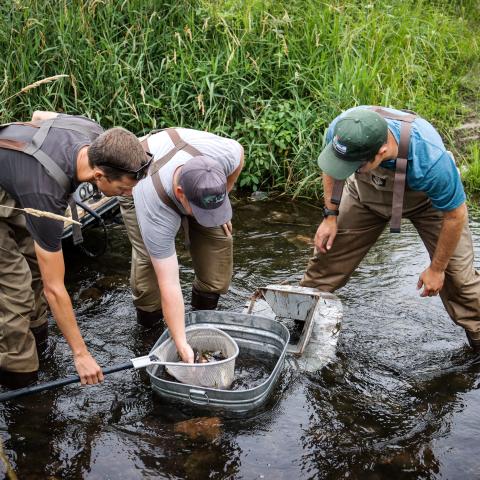
Webinar
USDA Funding for Wisconsin Woodland Owners Webinar
October 3, 2023

The Joint Chiefs' Landscape Restoration Partnership (JCLRP) enables NRCS and the Forest Service to collaborate with agricultural producers and forest landowners to invest in conservation and restoration at a big enough scale to make a difference.
Working in partnership, and at this scale, helps reduce wildfire threats, protect water quality and supply, and improve wildlife habitat for at-risk species. Through the new three-year projects, landowners will work with local USDA experts and partners to apply targeted forestry management practices on their land, such as thinning, hazardous fuel treatments, fire breaks and other systems to meet unique forestry challenges in their area.
This project addressed wildfire threats, water quality, and wildlife habitat by removing down wood, treating invasive species in disturbed areas, and establishing trees as necessary. Water quality projects included improving aquatic organism passage, stream crossings, riparian forest buffers, and maintaining shade on streams in black ash wetlands threatened by emerald ash borer. Wildlife objectives included habitat creation for near threatened golden-winged warbler and critically imperiled monarch butterflies. Brook trout were also a focus and benefited from improved water quality. Forest projects focused on ash management, oak wilt, and sustainable forestry practices across other forest types, to enhance wildlife habitat, and water quality. Community benefits included reduction in fire risk, improvements to water quality and wildlife habitat, and more resilient forests. Working in coordination with the Wisconsin Tribal Conservation Advisory Council, treatments were designed to beneficially impact Tribal lands. These restoration actions helped bring in more travelers to the area and sustain the local forest products industry.
Partners: American Bird Conservancy, American Woodcock Society, Lumberjack Resource Conservation and Development Council, Marinette County Land Information Department, My Wisconsin Woods, Northwoods Land Trust, Ruffed Grouse Society, Trout Unlimited, University of Wisconsin Extension, Wisconsin Department of Natural Resources, Wisconsin Tribal Conservation Advisory Council, Wisconsin Woodland Owners Association, Wisconsin Young Forest Partnership

Click to download and view the map as a PDF:
The U.S. Department of Agriculture Natural Resources Conservation Service and the Forest Service joined forces in a Landscape Restoration Partnership to improve the health and resiliency of forests on public and private lands. The Forest Service and Natural Resources Conservation Service together invested $30 million in 13 projects across the nation. In Wisconsin, the Beartrap-Nemadji and Bad-Montreal Watersheds in northwest Wisconsin were selected to protect water quality and improve habitat for at-risk species across public and private lands.
The project focuses:
USDA has invested more than $286 million in 110 projects over eight years in Joint Chiefs’ Landscape Restoration Partnership projects, which focus on areas where public forests and grasslands intersect with privately-owned lands.
USDA will invest more than $48.6 million this year through the Joint Chief's Landscape Restoration Partnership for projects that mitigate wildfire risk, improve water quality, and restore forest ecosystems.
Contact your local service center to start your application.
Do you farm or ranch and want to make improvements to the land that you own or lease?
Natural Resources Conservation Service offers technical and financial assistance to help farmers, ranchers and forest landowners.

To get started with NRCS, we recommend you stop by your local NRCS field office. We’ll discuss your vision for your land.
NRCS provides landowners with free technical assistance, or advice, for their land. Common technical assistance includes: resource assessment, practice design and resource monitoring. Your conservation planner will help you determine if financial assistance is right for you.
We’ll walk you through the application process. To get started on applying for financial assistance, we’ll work with you:
Once complete, we’ll work with you on the application, or CPA 1200.
Applications for most programs are accepted on a continuous basis, but they’re considered for funding in different ranking periods. Be sure to ask your local NRCS district conservationist about the deadline for the ranking period to ensure you turn in your application in time.
As part of the application process, we’ll check to see if you are eligible. To do this, you’ll need to bring:
If you don’t have a farm number, you can get one from USDA’s Farm Service Agency. Typically, the local FSA office is located in the same building as the local NRCS office. You only need a farm number if you’re interested in financial assistance.
NRCS will take a look at the applications and rank them according to local resource concerns, the amount of conservation benefits the work will provide and the needs of applicants. View Application Ranking Dates by State.
If you’re selected, you can choose whether to sign the contract for the work to be done.
Once you sign the contract, you’ll be provided standards and specifications for completing the practice or practices, and then you will have a specified amount of time to implement. Once the work is implemented and inspected, you’ll be paid the rate of compensation for the work if it meets NRCS standards and specifications.